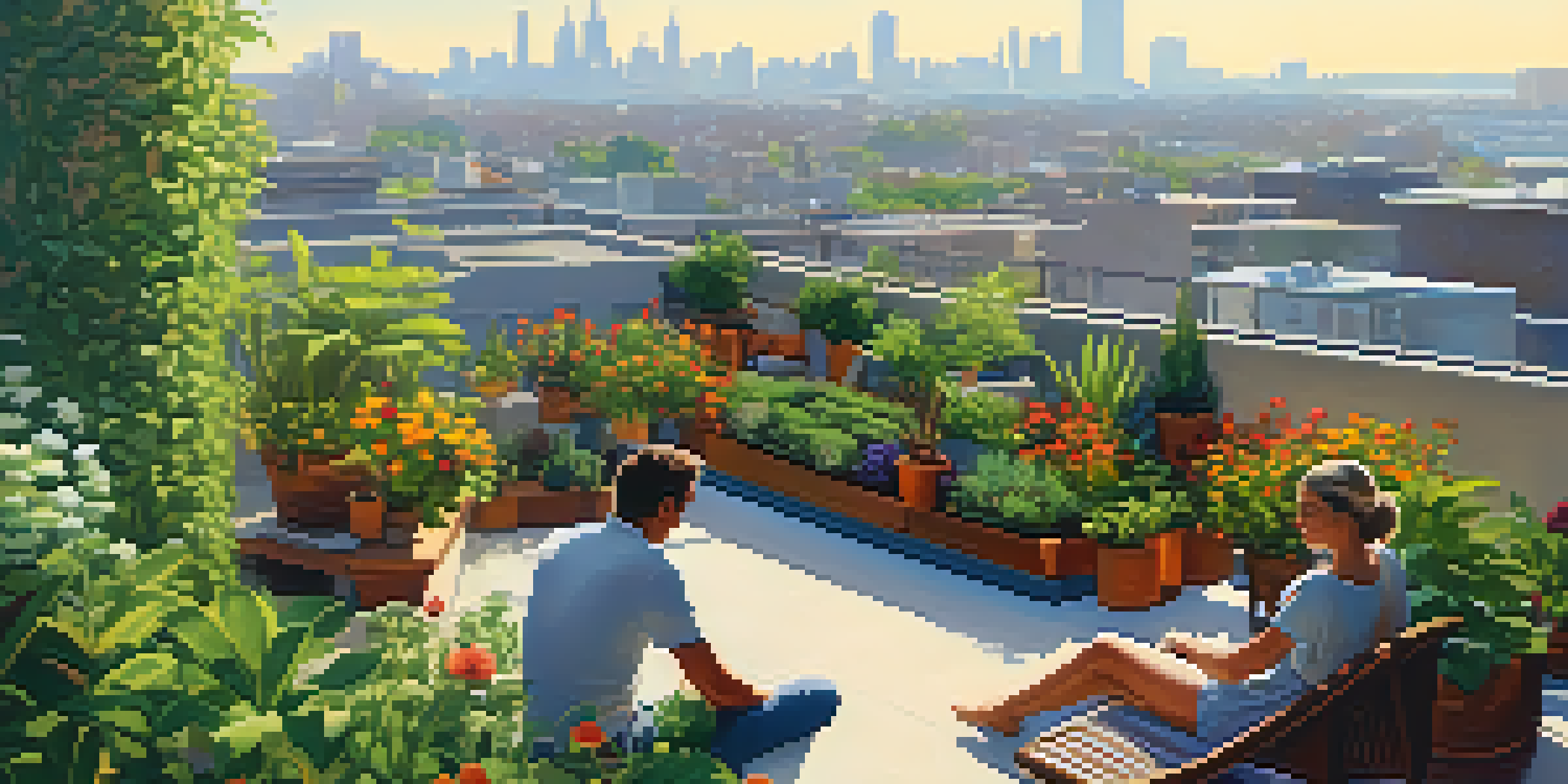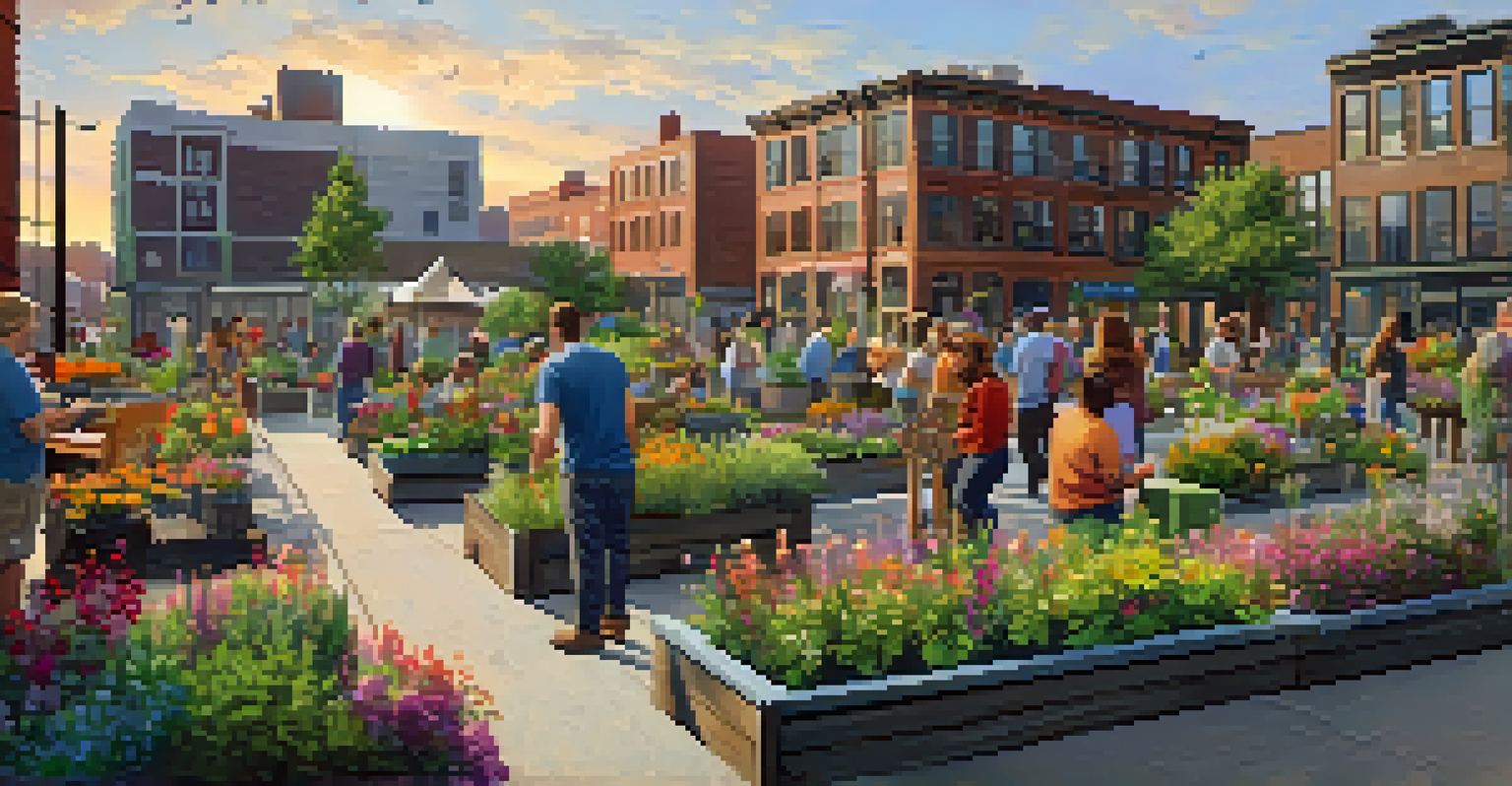The Psychological Benefits of Green Roofs for Residents

Understanding Green Roofs and Their Appeal
Green roofs, which are essentially gardens on rooftops, have gained popularity in urban environments. They not only provide aesthetic value but also serve practical purposes like insulation and stormwater management. Beyond the physical benefits, they play a significant role in enhancing mental well-being for residents.
The clearest way into the Universe is through a forest wilderness.
Imagine stepping out onto a rooftop filled with lush plants and flowers, a vibrant contrast to concrete surroundings. This natural escape offers a refreshing break from the hustle and bustle of city life. It’s like finding a peaceful oasis right at home, which can help reduce stress and promote relaxation.
As more people discover the psychological perks of green roofs, communities are starting to prioritize these green spaces. They create a sense of belonging and connection to nature, which is crucial in our increasingly urbanized world. This trend reflects a growing awareness of the mental health benefits associated with greenery in our living environments.
Connection to Nature and Mental Well-being
There's a wealth of research showing that spending time in natural environments can lead to improved mental health. Green roofs provide a unique opportunity to foster this connection. Even a brief moment spent among plants and flowers can evoke feelings of tranquility and contentment.

One study found that just looking at greenery can lower blood pressure and reduce anxiety. This simple act of engaging with nature can have profound effects on our mood and overall well-being. Green roofs serve as a daily reminder of the beauty of nature, even in dense urban settings.
Green Roofs Boost Mental Well-being
Green roofs provide a serene escape from urban life, enhancing mental health through connection with nature.
Moreover, when residents interact with these green spaces, they often experience a sense of accomplishment and pride. Caring for plants, watching them grow, and enjoying the fruits of their labor can enhance feelings of happiness. This connection is vital for nurturing a positive mental state.
Enhancing Community Cohesion and Interaction
Green roofs can act as social hubs, bringing residents together and fostering a sense of community. When people gather in these shared spaces, they often strike up conversations and build relationships. This interaction can combat feelings of isolation prevalent in urban living.
In every walk with nature one receives far more than he seeks.
Consider the scenario where neighbors collaborate on maintaining a rooftop garden. As they work together, they not only cultivate plants but also camaraderie. These shared experiences contribute to a supportive community atmosphere that enhances everyone’s mental well-being.
Additionally, community gardens on roofs can promote inclusivity, as they often welcome individuals from diverse backgrounds. This melting pot of people creates a vibrant environment where different cultures and ideas flourish. The shared goal of nurturing the garden translates into mutual respect and understanding among residents.
Reducing Urban Heat and Stress Levels
Urban areas are notorious for their heat islands, where temperatures can soar compared to surrounding rural areas. Green roofs help mitigate this effect by providing natural cooling. This reduction in heat can lead to lower stress levels among residents, making their living environment more comfortable.
Imagine enjoying a sunny day on a rooftop that’s several degrees cooler than the streets below. This comfortable environment encourages more outdoor activities, such as relaxing or socializing, which can significantly enhance mood and reduce stress. It’s a simple yet effective way to beat the heat and promote well-being.
Fostering Community Connection
These shared green spaces encourage social interaction, helping to combat urban isolation and build stronger communities.
Moreover, the cooling effects of green roofs contribute to a healthier living space overall. By improving air quality and reducing the need for air conditioning, they promote a more sustainable lifestyle. This not only benefits individual residents but also the community as a whole.
Promoting Mindfulness and Relaxation
Engaging with green roofs can serve as a form of mindfulness practice. The act of tending to plants and being present in a natural setting encourages individuals to focus on the moment rather than stressors of daily life. This can be a powerful tool for enhancing mental clarity and relaxation.
For instance, taking a few moments to water plants or simply admire the view can provide a much-needed break from a busy schedule. It allows residents to pause, breathe, and reconnect with their surroundings. This moment of tranquility can do wonders for mental health.
Furthermore, incorporating seating areas or quiet nooks on green roofs can create perfect spots for meditation or reflection. These tranquil spaces can become personal retreats where residents can escape from their fast-paced lives, promoting greater emotional resilience.
Inspiring Environmental Stewardship
Having a green roof encourages residents to become more environmentally conscious. As they see the benefits of nurturing plants and creating a sustainable space, they may be inspired to adopt eco-friendly practices in other aspects of their lives. This shift in mindset can enhance their overall sense of purpose and well-being.
For example, residents might start composting, recycling more diligently, or reducing their carbon footprint. This newfound commitment to sustainability fosters a stronger connection to the environment and reinforces the importance of protecting natural resources. It’s a ripple effect that can lead to positive changes in both individual and community behavior.
Promoting Environmental Awareness
Engaging with green roofs inspires residents to adopt eco-friendly practices, fostering a deeper connection to the environment.
Moreover, this stewardship can create a deeper appreciation for nature and the local ecosystem. As residents engage in environmentally friendly practices, they often develop a stronger bond with the world around them. This connection can significantly contribute to their emotional and mental health.
Conclusion: The Holistic Impact of Green Roofs
In conclusion, green roofs offer a multitude of psychological benefits for residents. They provide an essential connection to nature, enhance community interaction, and promote mindfulness. All of these factors contribute to improved mental health and overall life satisfaction.
As urban areas continue to grow, the importance of integrating green spaces into our living environments becomes increasingly clear. Green roofs not only combat the challenges of city living but also enhance the quality of life for those who inhabit them. It’s a win-win for both residents and the environment.

By prioritizing green roofs, we are investing in our mental well-being and the health of our communities. Embracing these green solutions can create a more harmonious balance between urban life and nature, leading to happier, healthier residents.